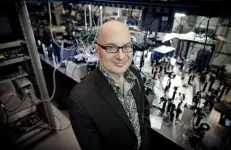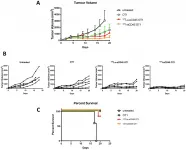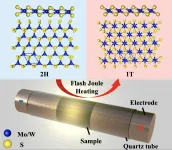(Press-News.org) A team led by University of Minnesota Twin Cities researchers has discovered a groundbreaking one-step process for creating materials with unique properties, called metamaterials. Their results show the realistic possibility of designing similar self-assembled structures with the potential of creating "built-to-order" nanostructures for wide application in electronics and optical devices.
The research was published and featured on the cover of Nano Letters, a peer-reviewed scientific journal published by the American Chemical Society.
In general, metamaterials are materials made in the lab so as to provide specific physical, chemical, electrical, and optical properties otherwise impossible to find in naturally occurring materials. These materials can have unique properties which make them ideal for a variety of applications from optical filters and medical devices to aircraft soundproofing and infrastructure monitoring. Usually these nano-scale materials are painstakingly produced in a specialized clean room environment over days and weeks in a multi-step fabrication process.
In this new research, a University of Minnesota team was studying a thin-film material called strontium stannate or SrSnO3. During their research, they noticed the surprising formation of checker-board patterns at the nano scale similar to the metamaterial structures fabricated in the costly, multistep process.
"At first we thought this must be a mistake, but soon realized that the periodic pattern is a mixture of two phases of the same material with different crystal structures" said Bharat Jalan, the senior author of the study and an expert in material synthesis who is the Shell Chair in the University of Minnesota's Department of Chemical Engineering and Materials Science. "After consulting with colleagues at the University of Minnesota, University of Georgia, and City University of New York, we realized that we may have discovered something quite special that can potentially have some unique applications."
The material had spontaneously organized into an ordered structure as it changed from one phase to another. During what is called a "first-order structural phase transition" process, the material moved into a mixed-phase in which some parts of the system completed the transition and others did not.
"These nanoscale periodic patterns are the direct consequence of the first-order structural phase transition in this material," said University of Minnesota aerospace engineering and mechanics Professor Richard James, a co-author of the study and a Distinguished McKnight University Professor. "For the first time, our work enables a host of possibilities for utilizing reversible structural phase transformations with nanoelectronic and photonic systems."
In fact, the team demonstrated a process for the first-ever, self-assembled, tunable nanostructure to create metamaterials in just one step. The researchers were able to tune the ability to store electrical charge property within a single film using temperature and laser wavelength. They effectively created a variable photonic crystal material with 99 percent efficiency.
Using high-resolution electron microscopes, the researchers confirmed the unique structure of the material.
"We observed that the boundaries between these crystallographic phases were sharply defined at the atomic scale, which is remarkable for a self-assembled process," said Professor Andre Mkhoyan, a co-author of the study, an expert in advanced electron microscopy, and the Ray D. and Mary T. Johnson/Mayon Plastics Chair in the Department of Chemical Engineering and Materials Science at the University of Minnesota.
The researchers are now looking to future applications for their discovery in optical and electronic devices.
"When we started this research, we never thought about these applications. We were driven by the fundamental study of the physics of the material," Jalan said. "Now, all of a sudden, we seem to have opened up a completely new area of research, which is driven by the possibility of many new and exciting applications."
INFORMATION:
In addition to Jalan, the team included University of Minnesota researchers Abhinav Prakash, Ashley Bucsek, Tianqi Wang, Tristan K. Truttmann, Hwanhui Yun, K. Andre Mkhoyan, and Richard James; University of Georgia researchers Alireza Fali and Yohannes Abate; City University of New York researchers Michele Cotrufo and Andrea Alù; and Argonne National Laboratory researchers Jong-Woo Kim and Philip J. Ryan.
The research was primarily funded by the National Science Foundation (NSF), and the Air Force Office of Scientific Research (AFOSR) with additional support from the University of Minnesota Institute on the Environment, Norwegian Centennial Chair Program, and two Vannevar Bush Faculty Fellowships. Work at the University of Minnesota involving thin film characterization was supported by the U.S. Department of Energy. Parts of the research were carried out at the Minnesota Nano Center and Characterization Facility at the University of Minnesota, funded in part by the National Science Foundation. Additional work was completed at the Advanced Photon Source, an Office of Science User Facility operated for the U.S. Department of Energy Office of Science by Argonne National Laboratory.
To read the full research paper entitled "Self-Assembled Periodic Nanostructures Using Martensitic Phase Transformations" visit the ACS Publications website.
HOUSTON - (Jan. 11, 2021) - A sweet new process is making sour more practical.
Rice University engineers are turning carbon monoxide directly into acetic acid -- the widely used chemical agent that gives vinegar its tang -- with a continuous catalytic reactor that can use renewable electricity efficiently to turn out a highly purified product.
The electrochemical process by the labs of chemical and biomolecular engineers Haotian Wang and Thomas Senftle of Rice's Brown School of Engineering resolves issues with previous attempts to reduce carbon monoxide (CO) into acetic acid. Those processes required additional steps to purify ...
(Boston)--Little previous research has examined the effects of Dense Breast Notifications (DBNs), but a new study suggests the legislatively required notifications have achieved partial success: women living in states in which in DBNs are mandated had higher rates of being informed about personal breast density and of having had breast density discussions with providers, though rates were low overall.
DBNs are a written notification to a woman after a mammogram with information about breast density. The goal is to motivate her to speak with her doctor about her personal risk and determine if supplemental screening for breast cancer is appropriate. DBNs are mandated in more than 38 states and the Food Drug ...
Scientists from the University of Bath have made a sustainable polymer using the second most abundant sugar in nature, xylose.
Not only does the new nature-inspired material reduce reliance on crude oil products, but its properties can also be easily controlled to make the material flexible or crystalline.
The researchers, from the University's Centre for Sustainable and Circular Technologies, report the polymer, from the polyether family, has a variety of applications, including as a building block for polyurethane, used in mattresses and shoe soles; as a bio-derived alternative to polyethylene glycol, a chemical widely used in bio-medicine; or to polyethylene oxide, ...
An international team of researchers, including Professor END ...
PHILADELPHIA -- (Jan. 11, 2020) -- Mutations that inactivate the ARID1A gene in ovarian cancer increase utilization of the glutamine amino acid making cancer cells dependent on glutamine metabolism, according to a study by The Wistar Institute published online in Nature Cancer. Researchers also showed that pharmacologic inhibition of glutamine metabolism may represent an effective therapeutic strategy for ARID1A-mutant ovarian cancer.
Up to 60% of ovarian clear cell carcinomas (OCCC) have inactivating mutations in the ARID1A tumor suppressor gene. These ...
Oncotarget recently published "Targeted lymphodepletion with a CD45-directed antibody radioconjugate as a novel conditioning regimen prior to adoptive cell therapy" which reported that Chimeric antigen receptor T cell therapies, and adoptive cell therapy in general, represent one of the most promising anti-cancer strategies.
In contrast to relatively non-specific chemotherapy-derived lymphodepletion, targeted lymphodepletion with radioimmunotherapy directed to CD45 may be a safer and more effective alternative to target and deplete immune cells. Here the authors describe the results ...
For the brain to learn, retain memories, process sensory information, and coordinate body movements, its groups of nerve cells must generate coordinated electrical signals. Disorder in synchronous firing can impair these processes and, in extreme cases, lead to seizures and epilepsy.
Synchrony between neighboring neurons depends on the protein connexin 36, an essential element of certain types of synaptic connections that, unlike classical chemical synapses, pass signals between neurons through direct electrical connections. For more than 15 years, scientists have debated the tie between connexin 36 and epilepsy.
Now, a team of Virginia Tech scientists led by Yuchin Albert Pan, an associate professor at the Fralin Biomedical Research ...
Many policymakers and educational institutions hope to boost their economies by stimulating students' entrepreneurial intentions. To date, most research concluded that entrepreneurship education could increase these intentions by improving the image that students have of entrepreneurship as a career option, making them see how their environment can help them become entrepreneurs or increasing their self-confidence regarding their entrepreneurial skills. However, recent studies show that even if these goals are achieved, students' entrepreneurial intentions often ...
HOUSTON - (Jan. 11, 2021) - Rice University scientists have extended their technique to produce graphene in a flash to tailor the properties of other 2D materials.
The labs of chemist James Tour and materials theorist Boris Yakobson reported in the American Chemical Society's ACS Nano they have successfully "flashed" bulk amounts of 2D dichalcogenides, changing them from semiconductors to metallics.
Such materials are valuable for electronics, catalysis and as lubricants, among other applications.
The process employs flash Joule heating -- using an electrical charge to dramatically raise the material's temperature -- to convert semiconducting molybdenum disulfide and tungsten disulfide. The duration of the pulse and select additives can also control the now-metallic products' ...
DURHAM, N.C. - A Duke-led team of scientists has developed a bio-compatible surgical patch that releases non-opioid painkillers directly to the site of a wound for days and then dissolves away.
The polymer patch provides a controlled release of a drug that blocks the enzyme COX-2 (cyclooxygenase-2,) which drives pain and inflammation. The study appears Jan. 10, 2021 in the Journal of Controlled Release.
When they started "We were making hernia meshes and different antimicrobial films," said Matthew Becker, the Hugo L. Blomquist professor chemistry at Duke, and last author on the paper. "We thought you could potentially put pain drugs or anesthetics in the film if you ...






